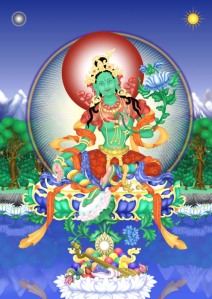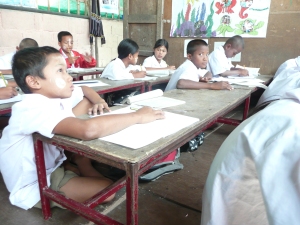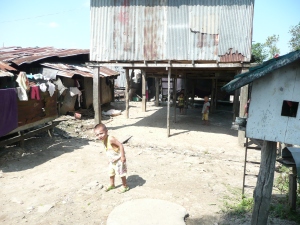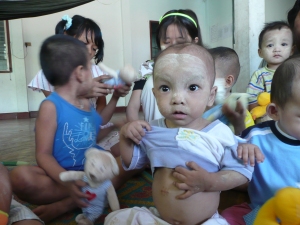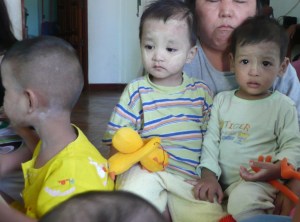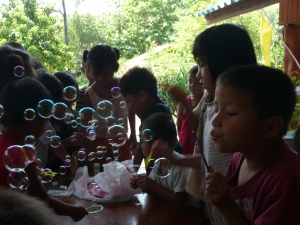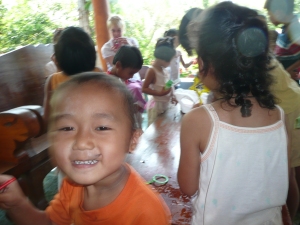You are currently browsing the monthly archive for July 2010.
I can’t believe I forgot to post about this! Our file flew away to Thailand this week!!!!
I am still in the Solomon Islands for work, but we got an email (which I read at 11pm after just getting back to the hotel from a 13 and half hour day at a workshop) but it said “your dossier has been couriered to Thailand”. – YAY!!! That sure woke me up!! I called husbot right away in Australia.
It looks like the removal of all obsticals has been working so far because the time between sending in our forms and their going to Thailand has been the quickest part of the process so far. Husbot had been giving me updates based on cheques being cleared “the Thai consulate has deposited their cheque” etc ” the translating service has deposited their cheque” etc etc but still it was quite surprising how quickly that file got itself ready, packed it’s bags and flew it’s way over to Thailand! Thank you my dear friend Green Tara – praise to you!
So that means that from now on it REALLY is just a waiting game. A long waiting game that will teach me patience to be sure. Thanks to all the family and friends who have helped us through the process this far, we started in October 2008, so it has taken 19 months to get to here.
Still it is so nice to feel one step closer to my future children, whomever they are and wherever they are now.
last night I woke up in the middle of the night and could not get back to sleep. This has been happening to me a lot lately. I start thinking about things… work… the adoption etc and then my mind is racing and I can’t quiet my mind.
Anyway I am still in the Solomon Islands and I have been reading the book Buddha by Karen Armstrong. It is such a beautiful book, I want to read her other books. She is a former Catholic nun who is now a writer and she writes about key historic figures in different religious ideologies. Here other books are: A History of God: The 4,000 Year Quest of Judaism, Christianity and Islam, and Muhammad: A Biography of the Prophet and The Battle for God there are others too. She has a beautiful writing style and approaches these historical figures of whom there are many myths and legends about as a biographer – refering to historical text etc.
Anyway, why bad Buddhist? Because when I got to the end and Buddha taught his last teaching and died I sobed and sobed into the night (in fact I am crying right now). I know the story of Buddha’s life and as a Buddhist I don’t view death with the same saddness that many feel. His death was not a shock to me, he died over 2500 years ago! – I have heard the story in general terms many times, his approach to his own death became a very important teaching in itself. So why the tears? Maybe it was just Karen Armstrong’s beautiful writing style and the small details I did not know before that made me cry….
No, it is because I am so far from enlightenment. I felt so much sympathy and compassion for Ananda the Buddha’s closest companion and one of his oldest followers who was with him at his death. Ananda had spent so much time with the Buddha, had listened directly to so many teachings from the Buddha, but he was unable to detatch himself enough from the self he was unable to achieve enlightenment. He was attached or ‘clinging’ to the Buddha and so felt such great sorrow and heartbreak when he died. I felt the same way too and it made me realise how much attachment I still have and how much work I still need to do while I have this opportunity, while I have been blessed with this precious human existance.
for now I will start with trying to quiet my mind.
Mi Go Long Solomons! – Thats Solomon’s Pijin for “Where me now?”… ” I am in the Solomon Islands!”
Why? The because the other part of my work responsibilities are in the Pacific and our biggest project is in the Solomon Islands. Which is a really interesting place.
I don’t have a powerful connection to the Solomon Islands as I do in Thailand and other parts of Asia such as Tibet and Tibetan communities living in India and Nepal. In fact I find sometimes when I am here I have very strange emotional experiences. I feel the highs and lows in extreemes.
When the project is going well it is SO inspiring and fantastic that I think it could be the best project ever. But other times, when things might be a bit rocky (and all community projects get a bit rocky at times) then the lows are really devistating.
Other then the work I have emotional extreemes in other areas too. Like while I have been here I have had some really strong dreams about my future family. Dreams that feel so real that you wake up and have to check yourself. And in fact make you sure that you need to push for a certain kind of future…. it is strange.
Here in Solomons children/babies are called ‘Pikinini’ and I think it is the cuttest word! and the most appropriate word for babies! Especially Solomons babies because they are SOOOO cute!! With their lovely brown eyes and their wild afro’s in either brown or blonde. I get asked all the time “Yu got any Pikinini?” and I have to say “Mi no got any Pikinini yet” : ( …..
Last Saturday Husbot and I underwent a very important spiritual cleansing. Geshe Sampton and Yeshe-La helped us in our adoption journey by performing a 2 hour Green Tara puja for Husbot and I.
Green Tara is very skilled at the removal of all obstacles and so Geshe-la thought it would help us to do this ritual to purify Husbot and I and also to remove any obstacle between our beautiful future babies and ourselves. I am also including Green Tara mantras in my daily practice from now on. Traditionally a lot of couples would do this puja to assist with fertility (and other things) Geshe-la thought it would be the right thing because it is all about welcoming a child into our lives.
It was a really wonderful experience. While we were there Husbot and I were required to recite some mantras at times but mostly just to meditate on the puja and the importance of what was occurring. I was meditating on our future child/children. And at first my mind was so excited – as if it was suddenly electrified. I was getting these beautiful images of our future life but once that calmed down I just concentrated on sending out messages to our future child that we were doing all we could to ensure that even though things may seem uncertain for them now, we would be there for them in the end. A mantra came into my mind…
Baby, where ever you are, you are connected to us
Although everything around you feels uncertain and you may be surrounded by uncertainty
Know this, deep in your heart, in your very core – that you are, and you will be, protected with us.
While I was doing this Husbot was doing something really lovely, he was concentrating one all the people between us and our future children and repeating the loving-kindness mantra on them. Starting with the social workers here in Australia “May they be free from enmity, affliction and anxiety, and live happily”. Then the people at the Thai Embassy in Australia “May they be free from enmity, affliction and anxiety, and live happily”, then the people who will receive our file in Thailand “May they be free from enmity, affliction and anxiety, and live happily” etc etc… All the people he could think of in the process.It was a lovely day and I believe a really important thing to do on this journey to our family.
So a strange thing happened last week… people started to read my blog! hahahaha
It went from zero per post to up to 50 – wow. So I now feel I need to disclaim to people that I am absolutly hopeless at spelling and grammer and may feel quite exposed from time to time in this public space.
But on the other hand the most positive thing is that I have discovered new blogs! Some are private blogs and some are ones that I have not found before but people have messaged me. It is so lovely. I am really enjoying reading other peoples experiences and learning from them. I feel like this is a community and now I am a real part of it now.
So thanks everyone for your contribution! I love reading your stories (especially those who have already been alocated and have happy family pictures!) it does reassure me that it is worth hoping for a happy ending.
I feel I should have prefaced my post about the children in the Burmese orphanages, with the comment “this information is from discussions I have had with the carers in the orphanages, not from the Thai Department of Social Welfare” so of course they might have a different take on it.
But what I understood was that things depend on where the children end up. If they and up in an institution that is outside of the official department of Social Welfare system (like the Burmese refugee orphanages are) then the children cannot then go into Thai state care, and of course it is sometimes not known if their parents are Burmese or Thai.
I think that Burmese kids are only treated differently in that Burmese refugees and migrant worker (adults) are treated differently. They are in many cases seen as ‘illegal’s’ because they can’t leave the camps and legal work permits are hard to get (work permit amnesty’s occur very rarely) which means they can’t access Thai services – like hospitals etc very easily. So if a parent needed to make arrangements then they would not be able to access official Thai department of Social Welfare supported orphanages without exposing themselves as ‘illegal’ migrant workers. Below is a little extract from a talk I gave at a University about the work I do with Burmese refugees and migrant workers, it might give some more context to the situation.
Burmese Refugees and Migrant workers
People continue to migrate from Burma to Thailand and while there are currently 150,000 camp based refugees there is also an estimated 2 million other people from Burma trying to survive in Thailand, these people fall under the umbrella term of migrant workers, or working refugees.
Refugees from Burma come to Thailand for a wide range of reasons including: losing their land to the Burmese military, forced labour, systematic rape of ethnic women, flooding of land in mega-development projects, political harassment and persecution, shortage of food, lack of employment opportunities.
The distinction between “refugee” and “migrant worker” is in a sense semantics, since the Thai government does not recognise refugees, and all “migrant workers” or “working refugees” have faced situations of civil war and/or severe human rights abuses. And although the term “working refugees”, would probably be the most appropriate term for this evening, as it refers to people who have fled for survival to Thailand and with no other options available have sought work for their livelihood; here I will use the term migrant workers, as that is what Burmese labourers in Thailand are most commonly known as.
In 2004 Thailand held an “amnesty” for migrant workers already in Thailand, where migrant workers, previously deemed to be ‘illegal’ workers would register and receive an identity card. 1 million 280 thousand migrant workers registered at that time, some were from Cambodia, Laos and Malaysia, but the majority, 921,000 people were from Burma. Since 2004 some of these registered would have moved on or returned home, but many others would have been arriving in a continuum as steady as those who arrive into the camps. Because there has not been another amnesty and mass registration period it is difficult to determine exactly how many migrant workers from Burma are living in Thailand today, but the estimate is as high is 2 million.
The term migrant worker often brings a connotation that their reason for migration is purely economic; however the term refugee conjures a firm image of one needing assistance and being in desperate circumstance. However in the case of Burmese migrant workers in Thailand, it is not correct to view their migration as a choice. Migration for economic reasons might be considered distasteful or opportunistic to some, but for the people of Burma there is often little choice. The Burmese ruling junta have mismanaged the economy so completely that inflation is high, commodity costs can skyrocket with little warning, and in a country where it is estimated that around 95% of people live on less then $1 per day the effect is devastating. While the Junta will spend around 40% of its annual GDP on the military, they spend as little as 0.4% on health and 0.5% on education, all of these factors have pushed the people of Burma into desperate situations where simply surviving depends on migration.
Once in Thailand refugee workers are working in jobs shunned by the local workforce because of the poor pay and the sub-standard occupational health and safety (OH&S) standards. Migrant workers in Thailand work in the construction industry in booming places like Chiang Mai, and the tourist resorts on the beaches in Southern Thailand. They work in border towns like Mae Sot in garment factories, polishing gems and also in the temporary agricultural jobs like fruit picking, melon picking and seasonal planting. Some of the worst conditions reported to us are in the fisheries industry and seafood processing, where we hear of the worst conditions such as forced labour and child labour.
Migrant workers face;
- Exploitation
- Dangerous Occupational Health and Safety standards
- Poor living conditions
- Health problems
- Uncertainly, in terms of job security and a high risk of deportation
- Isolation
- Child labour
Exploitation:
Those that have registration cards have their cards confiscated by their employer – this leaves them extremely vulnerable to ‘raids’ that can occur at any time by Thai police.
Most migrant workers are paid below the Thai minimum wage. Although Thai law does not recognise the rights of refugees or of migrant workers – all workers in Thailand are protected by the minimum wage – yet often in the gem and garment factories of Mae Sot (and other areas) migrant workers only receive 90 bhat per day instead of the 170 minimum wage.
Some migrant workers are kept in slave labour conditions because their documents are confiscated. They work a month on with only a few days off and then often the day before they are due to be paid the workplaces are ‘raided’ and the migrants are deported by the police (who are in cahoots with the employer)… so they are never actually paid for their hard labour.
Dangerous Occupational Health and Safety standards:
Workers in the construction industry and factories are particularly vulnerable to workplace injury.
Injured workers have no compensation or rights of appeal against employers. They are often thrown out of their boarding house and are in desperate conditions.
Employers often hand them over to the police, one of the health clinics we work with has become a ‘dumping ground’ for Burmese migrant workers injured at work – if the police feel compassionately towards them they dump them at the clinic instead of back over the border into Burma (which used to be the usual practice).
The most common injuries to workers are broken, and shattered limbs, spinal injuries, loss of digits, hands or limbs as well as injuries to sight and hearing.
My work supports Migrant Worker Organisations who raise awareness about these issues with migrant workers themselves and also with the Thai Authorities to advocate on their behalf. They have sheltered migrant workers in safe houses while they have undergone treatment for injury and rehabilitation and also sheltered workers while they have launched claims against employees who are exploiting and underpaying migrant workers – often if these cases can go all the way through the courts then they win!! And the workers can claim compensation!
Poor living conditions & Health problems
Refugees from Burma arrive in Thailand often in poor health due to the dire economic, political and social situation in Burma.
They have very little information about health issues, particularly issues such as HIV or avian flu and are therefore vulnerable to communicable diseases.
The crowded conditions of worker dormitories where workers are often only given enough space to lie down to sleep exacerbate these medical problems and spreads communicable diseases.
Refugee worker women are also vulnerable to situations of violence and abuse by employers, local authorities and within their own communities. While the registration policies of Thailand provide refugee workers with a temporary status to work in Thailand, it does not provide refugee workers with an identity status nor include refugee workers in the social and cultural life of the country. Refugee workers are therefore isolated and excluded from mainstream society.
Whilst those registered for the Migrant Workers Card have access to the National Health Service (30 baht scheme) of Thailand their access is limited by language barriers, which is why MAP provide translators in hospitals. Refugee workers who have not been able to register have to pay full costs at state hospitals.
Transient nature of the work – means it is difficult to provide health information and access to programs like TB programs and anti-retroviral for migrant workers with HIV.
The Migrant Worker Organisations my work supports helps workers to be more aware by running local language health programs on radio and in free magazines.
Despite these conditions and risks most migrants still prefer to be in Thailand then Burma – which says a lot about conditions in Burma!
The situation for Children
People who are of a working age are also of a reproductive age. But the working conditions described above are not conducive for supporting a family life.
Employers often actively discourage families in the boarding houses or disallow families to be housed in the boarding houses. Some will not allow anyone to be housed who is not working – and so families feel pressured to make their children work. Parents in this situation may place their children in an orphanage either permanently or as a temporary measure.
Workers lives are transient, they often have to move for work – especially seasonal work such as agricultural work. If they have a family then they have to move often and this means that their children need to change schools or miss large sections of their schooling if there is no free or migrant worker children school available.
In Mae Sot alone there are 64 Migrant Worker schools recognised by the Thai education authorities and many more not recognised. The Burmese Migrant Worker Education Committee who are the umbrella groups for the 64 schools say there are 10,000 children of migrant workers under their care (in the 64 schools) but they estimate that that is only 25% of the number of children needing schooling in the area!
It is a HUGE task.
Here is some pics of one of the schools my organisation supports, The Burma Labour Solidarity Organisation School;
Although I have been to Thailand many times and I work with community groups who provide services to Burmese refugees, I have never been to one of the orphanages before.
It was for professional reasons. My work does involve any projects with orphanages, most of our work is with adults, not just on the Thai Burma Border but everywhere we work – our philosphy is that if you work with parents to improve their lives then they will be the ones looking after their own children. Our view on child sponsorship programs is that they are flawed and paternalistic. Our organisation works on principals of solidarity and empowerment. So I dont need to go for my work.
The other reason is personal. I was not sure how I would handle the visits and I always felt that these kids have enough problems, they dont need a silly white woman having an emotional breakdown in front of them!
Anyway, I did go this time. I felt it was time to go and I have some questions about the process. And I hope it is not too controversial to say what I am about to say but it really is concerning to me. It is based mostly on conversations I have had with people both here and in Thailand.
The long waiting times in Thailand have been put down to a few things, I have even had a social worker (in Australia) say ‘there is not enough children’ (!) to which a friend of mine whose mother volunteers at some Thai orphanage replied “there are more children going into these orphanages then coming out of them”.
I have also asked people who run orphanages for Burmese children in Thailand if they get any support from Thai authorities – they do not. And if you ask how children end up in the orphanage then it is the usual way, they are left there or found in the street, or somewhere else and brought to the orphanage. So how do you know if the children are Thai or Burmese? – You don’t. They just look after them all.
But it does mean that these children are not under the Thai Department of Social Welfare and therefore are not able to be adopted by anyone. Not by Burmese families (because the orphanages do not have the capacity to ensure that people would not be traficking the children), not to Thai families (because the department does not recognise them) and not by International families (because they are not in the system). So they will stay in the orphanage. Where they will be cared for as best they can, and educated etc. There are a lot of orphanages like this along the Thai Burma border, and all through Thailand.
Some lovely pictures from SAW Orphanage
And at the H2O Orphanage it was bubble blowing time:
If you would like to donate to either orphanage:
Social Action for Women (SAW) – Saw Orphanage: www.sawburma.org
H20 Orphanage – 73 MU 6, Soi Pa Latha Rd, Umphang Tak 63170 tel: 084-811-5504



